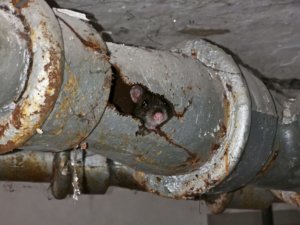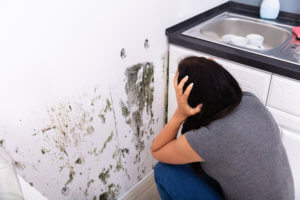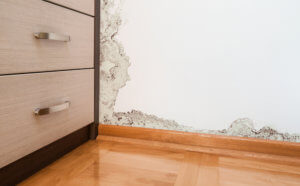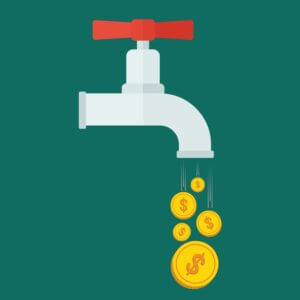Leaking Drain Pipe In Wall: 4 Big Signs
Do you have a leaking drain pipe in your wall? Are you looking for concrete evidence? In this article, we give you the five biggest signs of a leaking drain pipe in your wall. Most blogs out there will just give you the problem and leave you to research the solutions. Not here! At the bottom of this page, we give you the repair methods that work.
4 Big Signs Of A Leaking Drain Pipe In Your Wall
If you notice any of these signs, call a professional now before the leaking drain pipe turns into something else far worse.
1. Sewer Odor
If you begin to smell a foul odor near a wall, a drain pipe may be leaking. Your home drain pipes are designed to be airtight, allowing waste to move through your home unnoticed by your eyes or nose. In two-story homes, upstairs bathrooms usually send waste down through pipes in your walls.
Sewer odor comes with a rise in temperature. If you place your hand on a wall and you feel the heat, that’s another strong indicator that you’ve got a leaking drain pipe. The smells can continue through the rest of your home, rising out of toilets, showers, and floors.
Sewer odor is a complex mixture of toxic and nontoxic gases. Highly harmful components of sewer gas include hydrogen sulfide and ammonia. Sewer odor also contains methane, carbon dioxide, sulfur dioxide, and nitrous oxides. Exposure to low levels of hydrogen sulfide irritates the eyes and respiratory tract (that includes your nose, nasal cavity, pharynx, larynx, trachea, bronchi, and lungs). Other symptoms include,
Exposure to high concentrations of hydrogen sulfide can interfere with the sense of smell, making this warning signal unreliable. At extremely high levels, hydrogen sulfide can cause immediate loss of consciousness and death. If you smell sewer odor, address it now!
2. Mold Growth
As we mentioned above, the leaking drain pipe’s heat comes with even more problems. Mold! The increase in temperature in your walls creates the perfect condition for mold growth. In nature, mold helps decompose wood, leaves, and other natural debris. It’s not something you want in your home.
If you notice black or green spots appearing on a wall or floor, that’s mold taking over your home. Mold can grow on wood, wallpaper, ceilings, insulation, and floor carpet. The last place you want mold is your furniture, which can be ruined instantly. Mold also comes with health concerns, just like sewer odor. Hazards include,
There are also a small number of molds that produce mycotoxins. Individuals exposed to a high level of mycotoxins can suffer from nausea, fatigue, eye irritation, lung irritation, and headaches. If you can’t see the mold, it comes with a musty odor that can help you find it.
3. Wall Damage
If you smell the odor, see the mold on your wall, try touching the wall. If it’s spongy or soft, that’s humidity and vapors absorbing into the wood. Look out for paint bubbles building up filled with moisture. Maybe wallpaper is peeling off or soaking, falling apart. See if the drain pipe is leaking in another location and is dripping down. Sewage contains biohazards, chemicals, and microbes that absorb into your wall, requiring replacement.
4. Infestation
A leaking drain pipe in your wall not only brings odor, mold, and hazards but friends! Rats and mice love to travel the sewer, and if they find an opening to your home, they’re going to take it. Mice can fit through a hole the same diameter as two pencils, and rats can fit through openings as small as a quarter.

The German cockroach can enter openings as thin as a dime, while the American cockroach can get through holes as narrow as a quarter. That doesn’t include sewer flies, palmetto bugs, and other nasty creatures. If you see signs of rats or other pests, think before you call the exterminator. Killing the current intruders will only temporarily solve the problem. Fixing your drain pipes in your wall can keep them out for good.
What Can You Do About A Leaking Drain Pipe In Your Wall?
There are two solutions to fixing a leaking drain pipe: minor repairs and total replacement.
We break down the cost of potential repairs below. If leakage has been going on for a long time, and there is a lot of water damage, you may need to call restoration experts as well. They can help extract water from your home, dry your walls, clean any affected personal items, and help with any insurance claims. They may be able to stop the leak, but plumbers are the ones who can help install new plumbing systems.
Read more about – Drain pipe replacement options
Cost To Fix
If you have a leaking drain pipe, most plumbers won’t recommend minor repairs. They tend to be rush jobs and don’t solve the real problem. In that case, experienced plumbers suggest trenchless sewer repair or conventional sewer repair. The price depends on various factors, such as the pipe condition, ease of navigation, the amount of cleaning needed before the lining, the amount of piping, and the accessibility of the pipe.
Trenchless sewer repair can cost anywhere between $4,000-$15,000 for the average single-family home. Jobs range from a few feet of repair to hundreds of feet, thus changing the pricing per amount of needed work. There will always be a base cost starting at permitting, contractor mobilization, project minimums, and then prices move on from there.
Conventional sewer repair, on average, costs $50 to $450 per linear foot. The price to install brand new pipes throughout your home or yard could run to $15,000 because of all the extensive work, such as trenching and excavation.
Learn more about – Cost To Replace A Cast Iron Stack
Who can you call?
If you have a leaking drain pipe in your wall, call New Flow Plumbing! We’ll get you started with a CCTV sewer camera inspection to determine where your problems come from. Then, we give you a free repair estimate, followed by available repair options. Whatever the issue, New Flow Plumbing will have your drain pipes back to normal.








